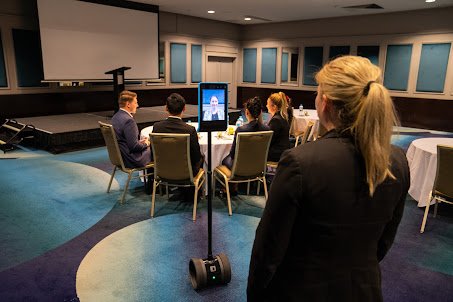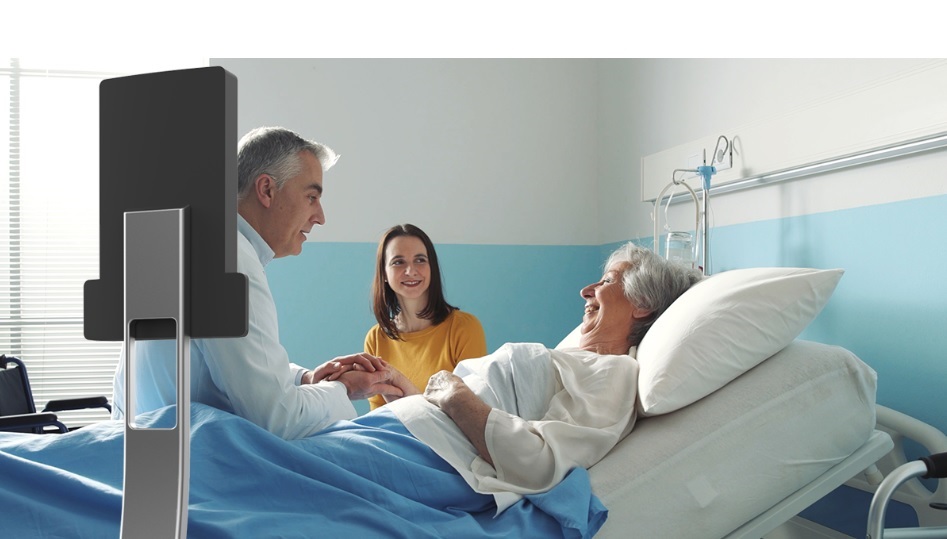Telepresence 101 - Learn the basics of Telepresence Robots
Interested in how telepresence robots can work for you, but wondering what exactly they can be used for? Join us in 'Telepresence 101', where we...

The term telepresence describes any technology which enables a person to simulate being in one location when they are in another location. This can include observing the surroundings of their virtual location, or even interacting with objects or people in that secondary location. Basic telepresence systems will include only visual and audio feedback. Frequently, this is accomplished by streaming video to the user through a static camera mounted in the secondary location. A simple form of interaction is letting the user control the direction/orientation of the camera, so they can see more of the surroundings in the remote location. Telepresence robots build off this general concept by enabling the user to control the robot and move throughout space in the remote location and interact with objects in the secondary location. Drive-able telepresence bots are robots that are set on a wheeled base and capable of movement, and telepresence robots are considered “adaptive” and distinct from more immersive yet stagnant telepresence systems.
Telepresence robots can simulate the height of a person by having the camera and display be mounted on a pole, with the camera positioned such that the device’s operator seems to actually be having eye contact with the user. While the degree of immersion for the operator is important to consider, how people interact with the operator is also an important consideration. Good telepresence robots can help make the experience less jarring.

Telepresence robots have a number of benefits over traditional telecommunications devices or non-robotic telepresence systems. For one, telepresence robots can drastically decrease travel costs for corporations that constantly implement them in lieu of travel to remote locations. Users of telepresence robots can remain present at the company headquarters and still attend meetings at offsite locations. By reducing travel, telepresence robots also cut down on CO2 emissions and help reduce a company’s carbon footprint. They are also an excellent tool for holding a video call using a telepresence robot.
Telepresence robots also have advantages over non-robotic telepresence systems. In contrast to a simple camera system, a robot can be controlled by the user to manipulate objects remotely, which enables functions like remotely handling the organization of items or tools. Future telepresence robots will be able to take voice commands and manoeuvre through dangerous/difficult environments thanks to improved sensors.
Telepresence robots can be used in work environments, school environments, or almost any context that can be imagined. Some examples of telepresence robot applications include uses in hospitals, schools, colleges, real estate agencies, nursing homes and museums. Schools and colleges are areas where telepresence robots having growing potential and adoption rates. Telepresence robots can be used in these environments for a number of different tasks.
Children who suffer from serious health problems can attend school remotely through telepresence robots, and telepresence robots can also allow teachers to teach classes remotely when some logistical problem prevents the teacher from being there in person. Telepresence robots can be used in hospitals to allow doctors to keep in touch with their patients even when they can’t be there physically, and they can also be used to let the patient’s families check in on patients from a distance. Similarly, telepresence robots are also of use in nursing homes, where family members can see how their relatives in the nursing home are doing. In terms of real estate applications, telepresence robots could be used to let prospective buyers remotely tour a property, or to let real estate agents check in on properties from afar. Meanwhile, museums could use telepresence robots to have remote experts walk guests through exhibits or to have special presentations from experts without having to fly the person in.
The cost of telepresence robots can vary dramatically with options to rent, lease or buy outright. Generally, the cheaper telepresence robots lack many of the functions that our higher-end telepresence robots have. However, there is an outstanding telepresence robot you can buy that does not compromise features for price, the Double3 robot.
Call 1300 342 546 to discuss a 30-day free trial or visit our website, www.telein.com.au/ to organise an onsite or remote demonstration of the technology!

Interested in how telepresence robots can work for you, but wondering what exactly they can be used for? Join us in 'Telepresence 101', where we...

2 min read
Telepresence robots are a relatively new innovation, but they have the potential to make a big impact on healthcare service delivery in remote...

2 min read
With COVID border travel and government restrictions preventing many of us to travel these days - we've been forced to find new...